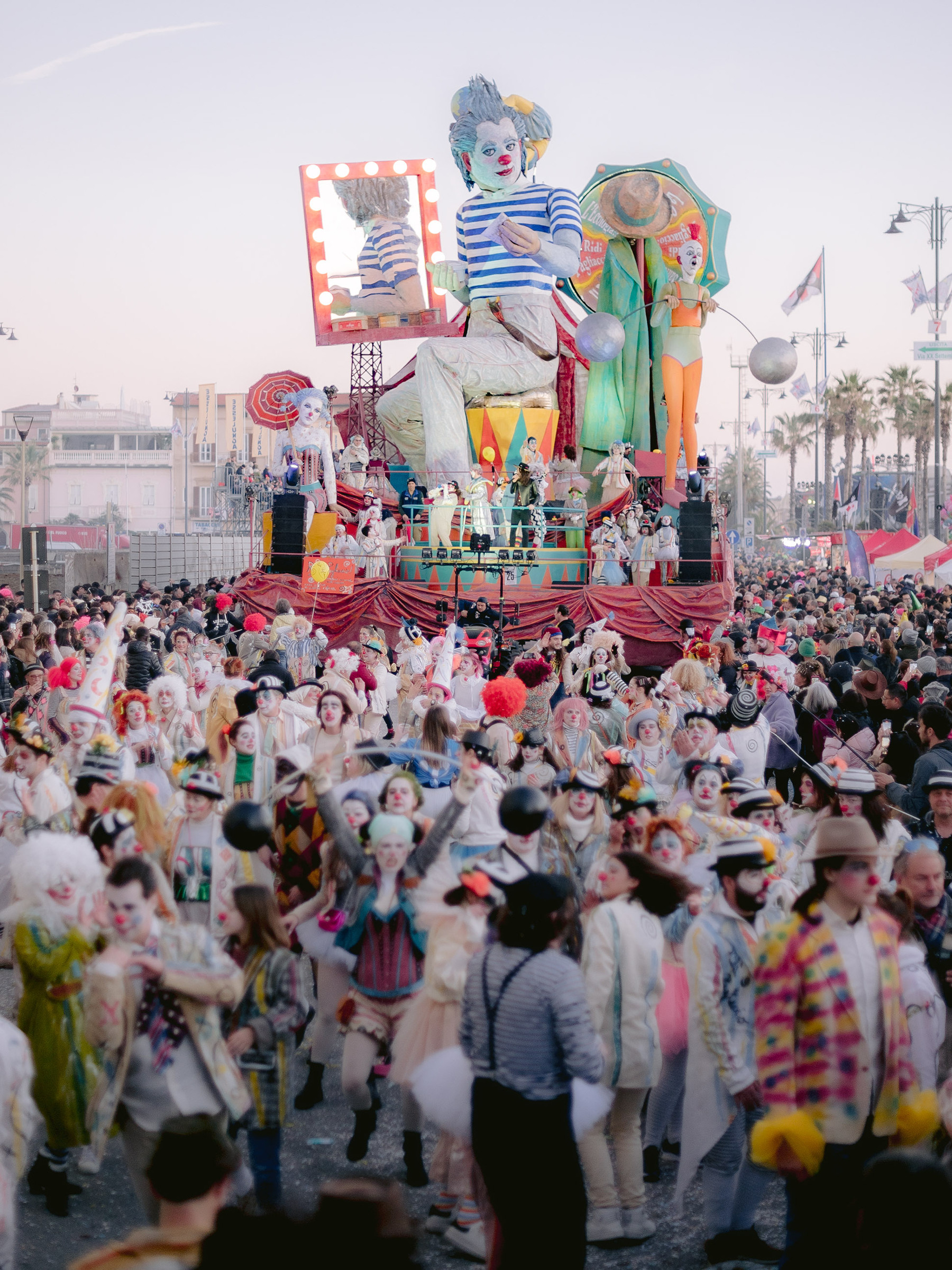
Laugh Pagliaccio, a float by the Lebigre family. Photo: Linda Nari
Carnevale originated in pagan rituals celebrating winter turning to spring. For Christians it offers a brief hiatus before the rigours of Lent – hence the name ‘carnem levare’ – which means ‘to take away meat’. This is a time to create chaos, to question and poke fun at authority and, for the artisans of Viareggio, the opportunity to say something meaningful to the public and get them involved.
La Cittadella del Carnevale, just outside Viareggio, is a circular complex with 16 hangar-like warehouses and a museum. It's here that we meet some of the artisans whose dizzying array of skills include design, art, modelling, mechanics, puppetry, welding, choreography and scenography. However, as in a circus, everyone has to do a bit of everything.
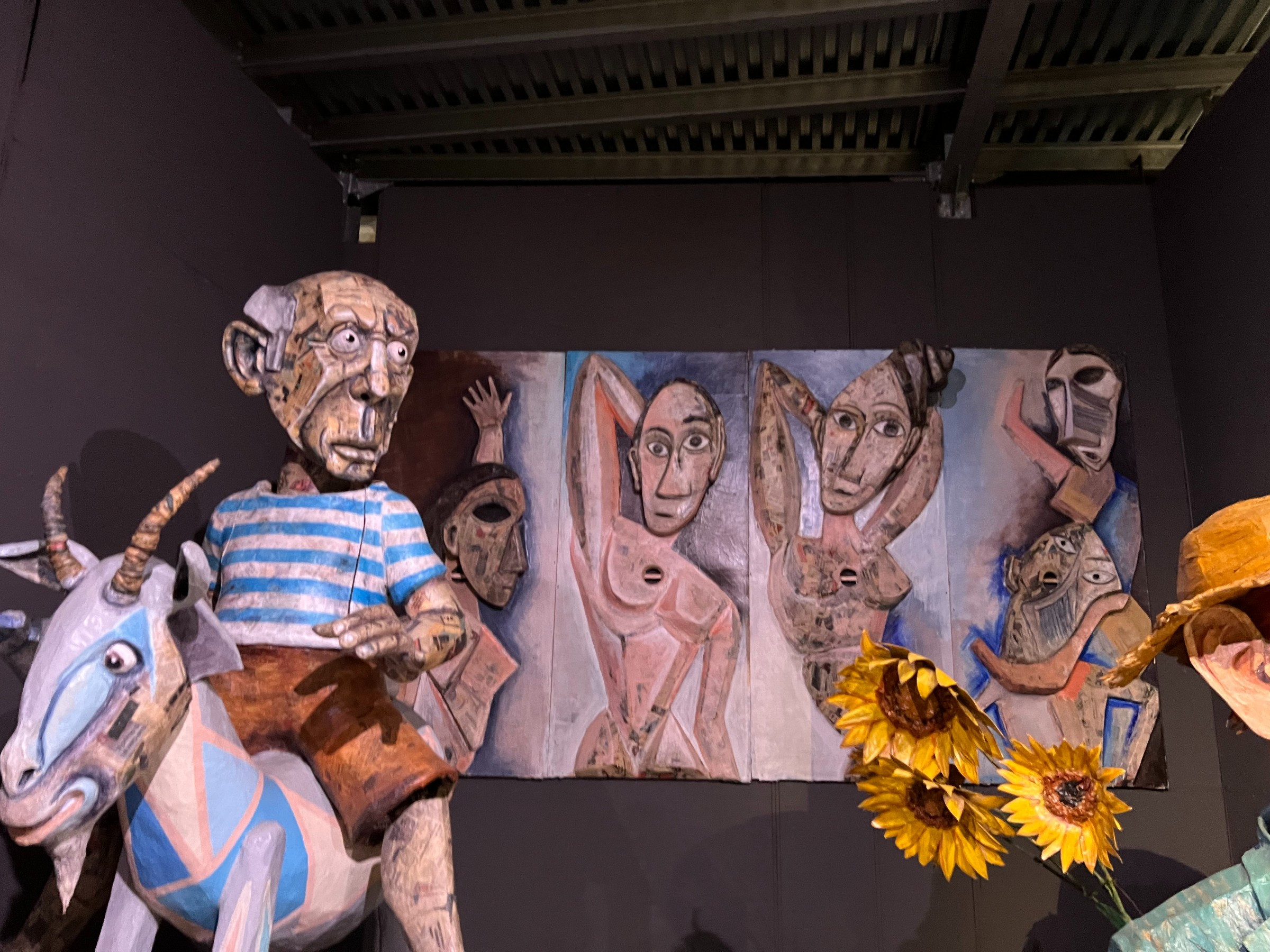
Picasso in Cittadella by Libero Maggini
— — —
The French Lebigre family travelled the world learning from other carnivals, and are credited with being the first to create a community theatre to perform in front of their floats. Each year they train 200 people from all walks of life to participate in their show. This year their grand float is entitled Laugh Pagliaccio, or the art of taking oneself seriously and features a clown looking at himself in the mirror as he readies himself for the show. Will he make us all laugh, or himself be the one to laugh at the world which has become a circus?
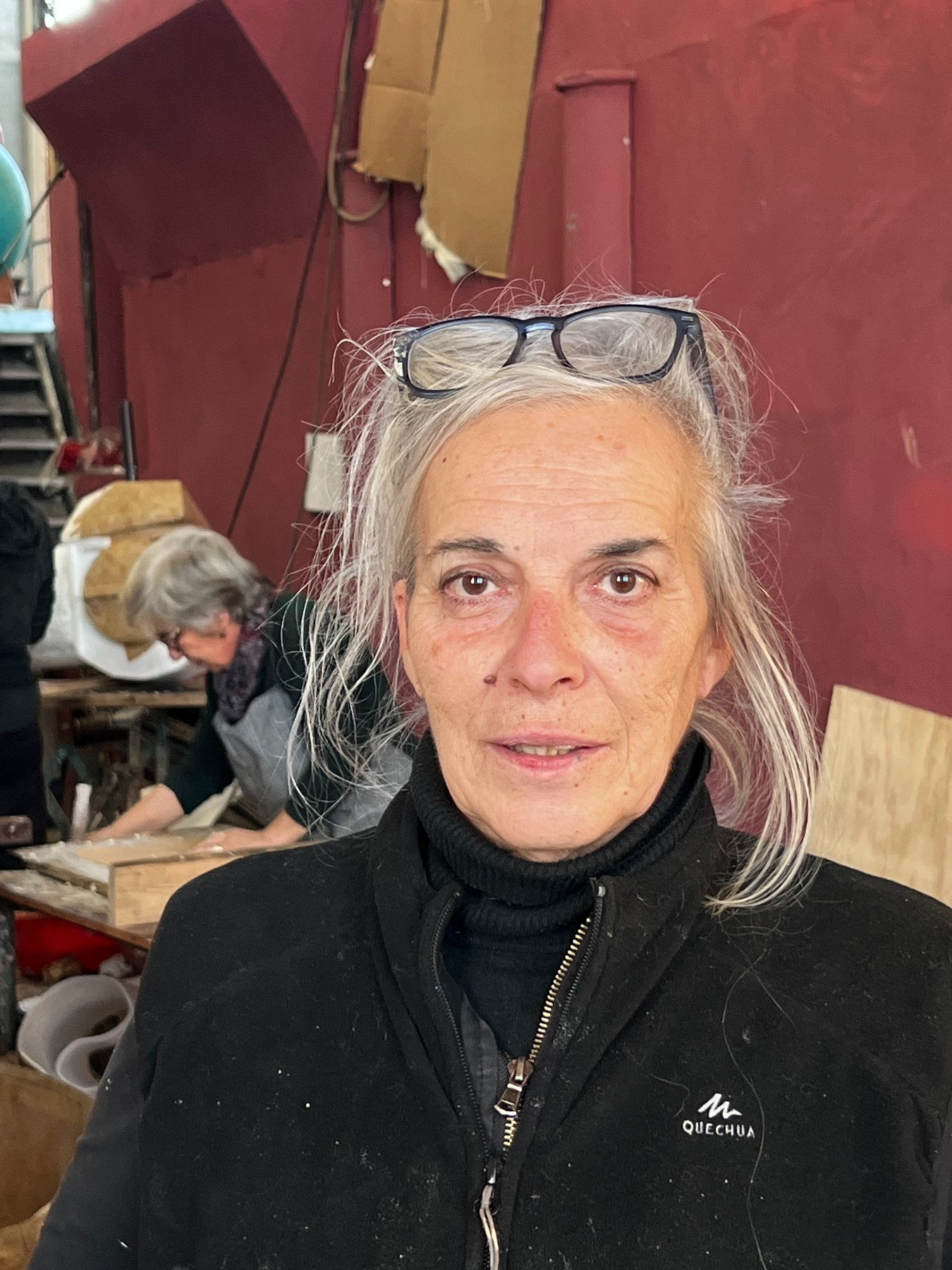
Corrine Lebigre

Elodie Lebigre. Photo: Linda Nari

Photo: Linda Nari
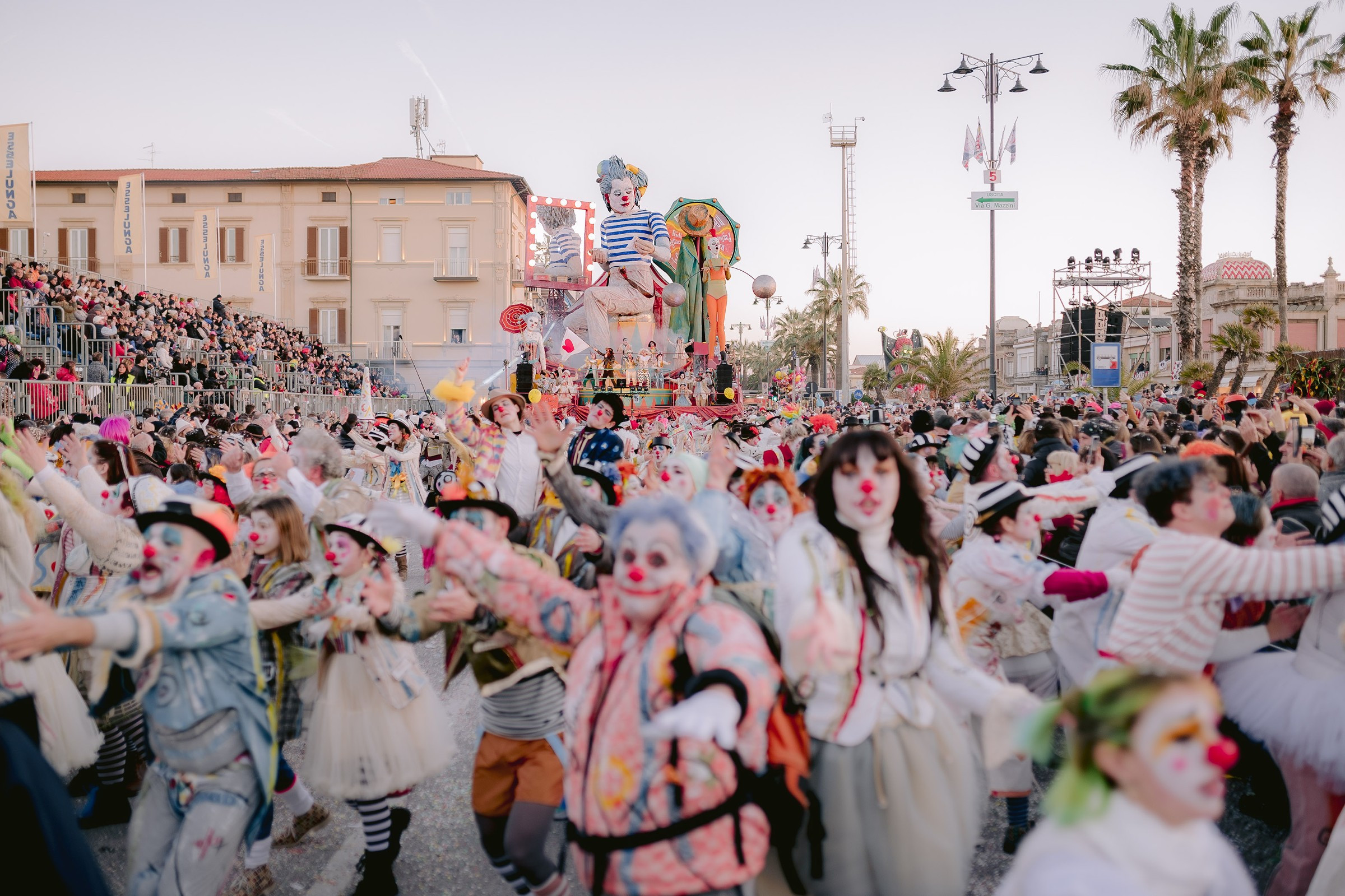
Photo: Linda Nari
— — —
Libero Maggini is an artist based in Pietrasanta who creates works in bronze, terracotta and marble. He is the son of two artists and each winter he works with his father at the Carnevale. This year, the 150th anniversary of the carnival, they created six figures for the masquerade category as a homage to Queen Elizabeth II and her dogs. It is titled Anglicani as a joke – ‘cani’ means dog in Italian.

Libero Maggini with two of his Anglicani
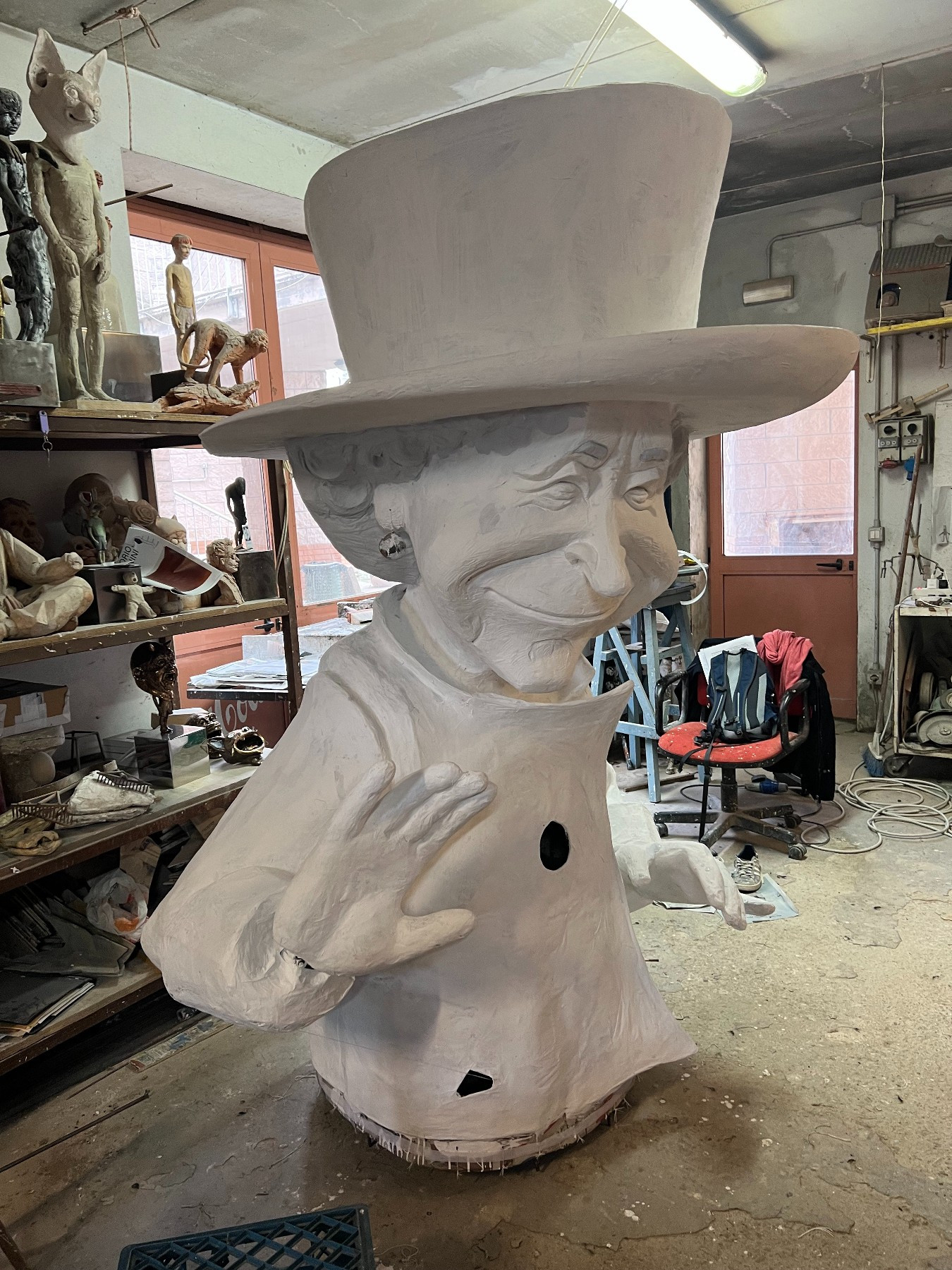
The Queen by Libero Maggini
— — —
Edoardo Ceragioli started competing in the Carnevale in 1998. This year his creation is titled There was a boy like me, which quotes a famous song by Gianni Morandi denouncing the stupidity of war. His creations depict memories of a young boy’s life cut short in the rubble. Here you can see him working on the backpack representing the boy’s schoolboy years.
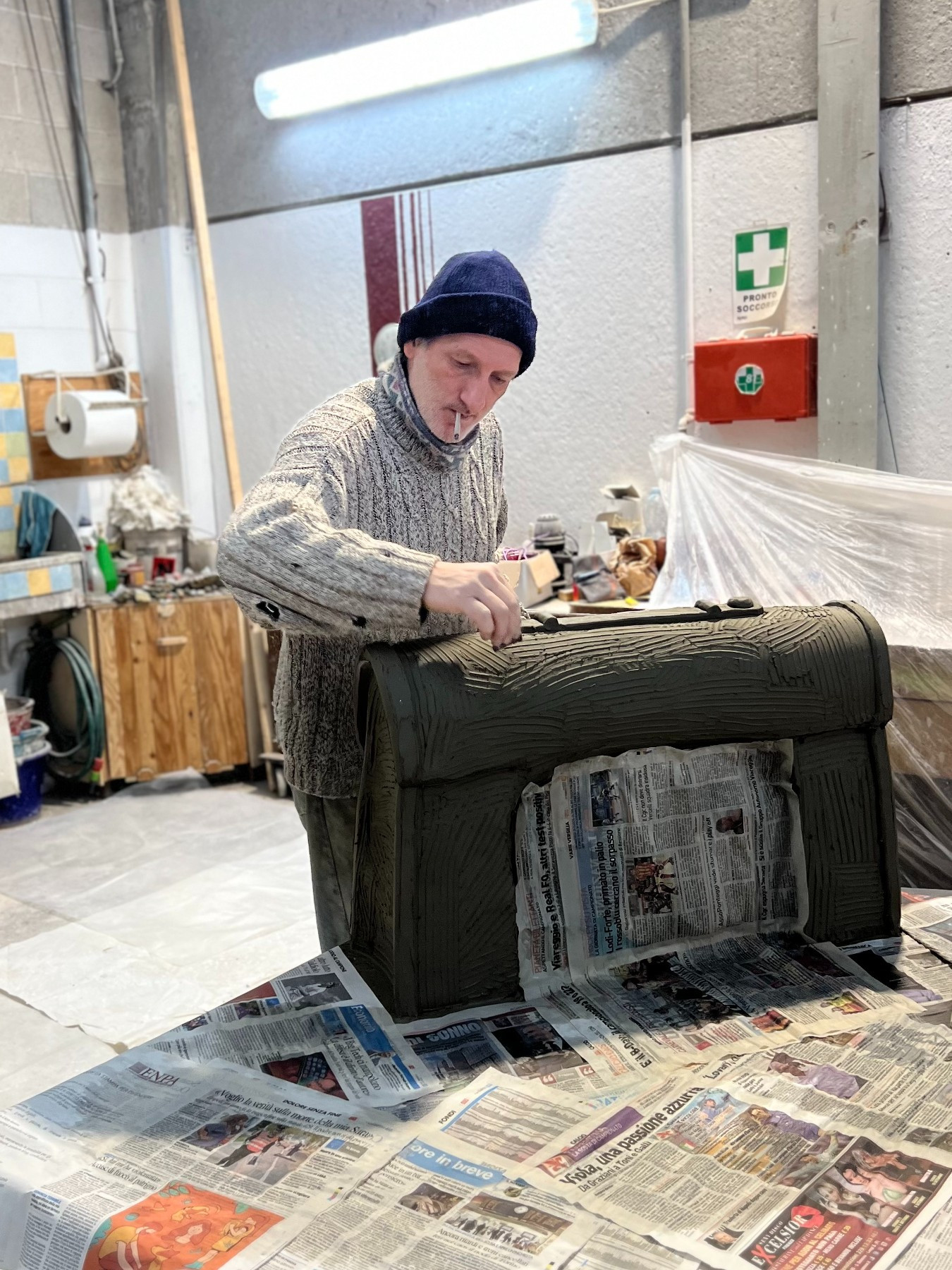
Edoardo Ceragioli
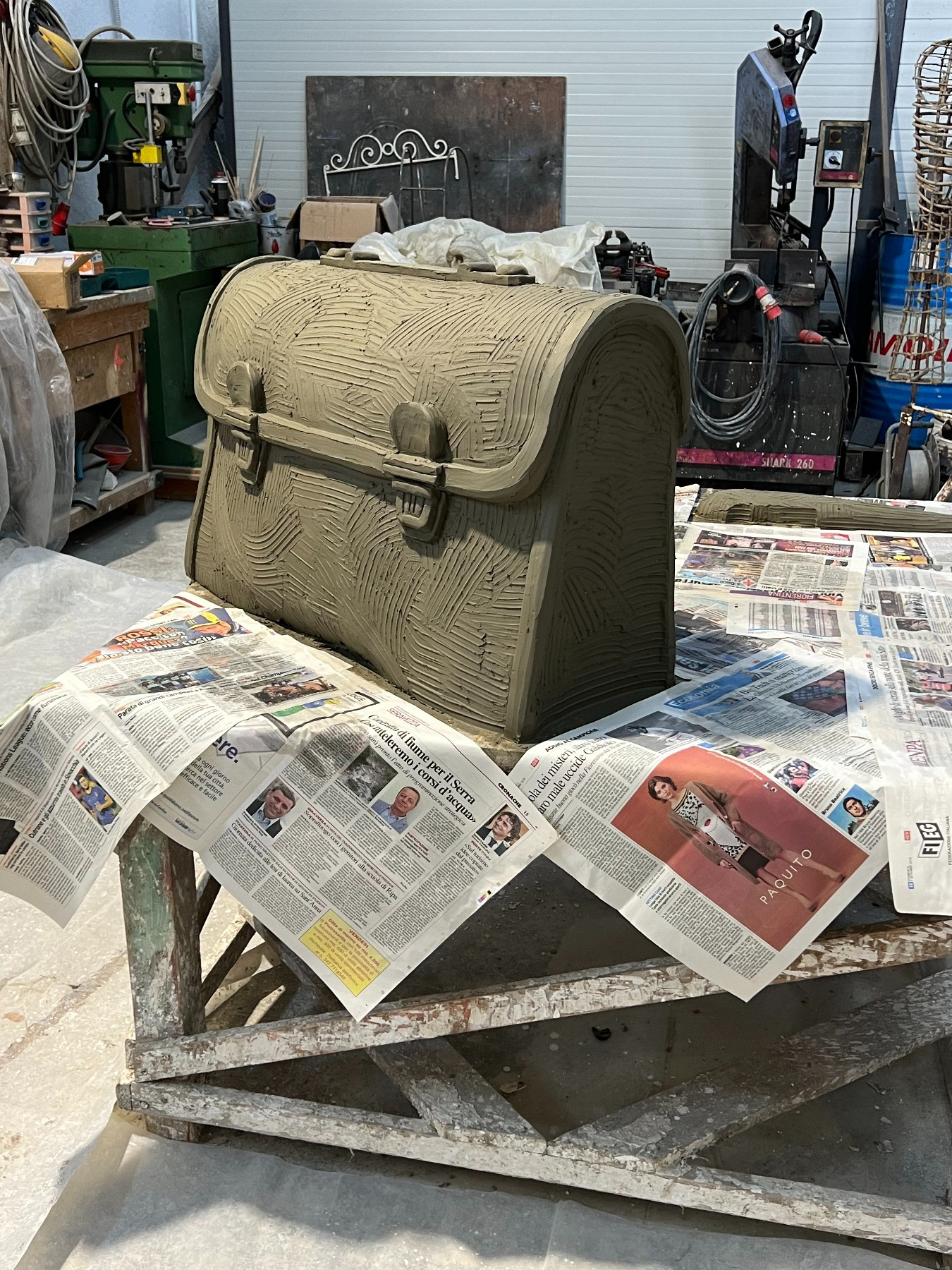
Francesco Manfré has been assisting Edoardo for some years and works as a lifeguard in Viareggio during the summer months. Here you can see him working with a colleague placing papier-mâché inside a mould.
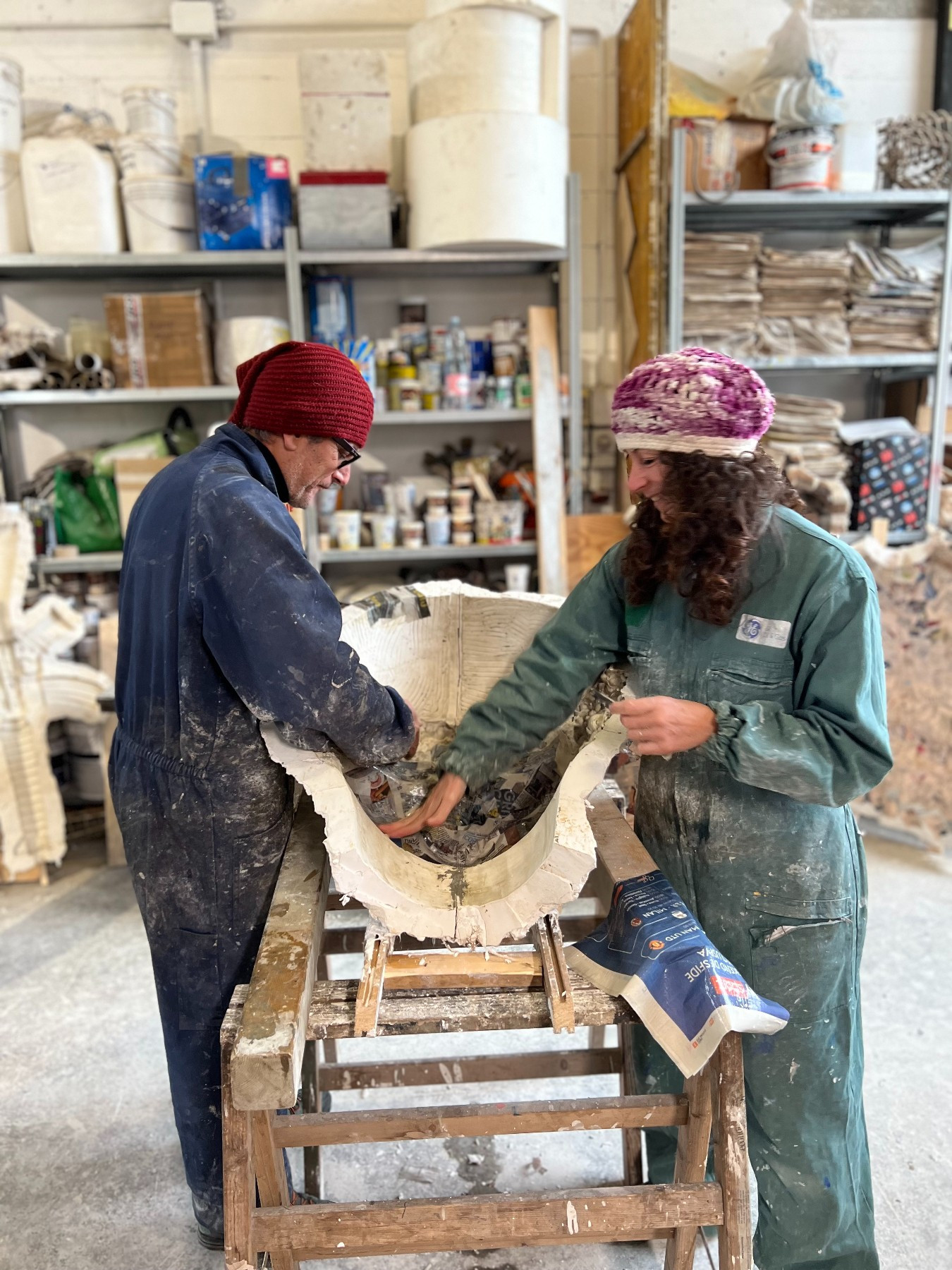
Francesco Manfré and colleague
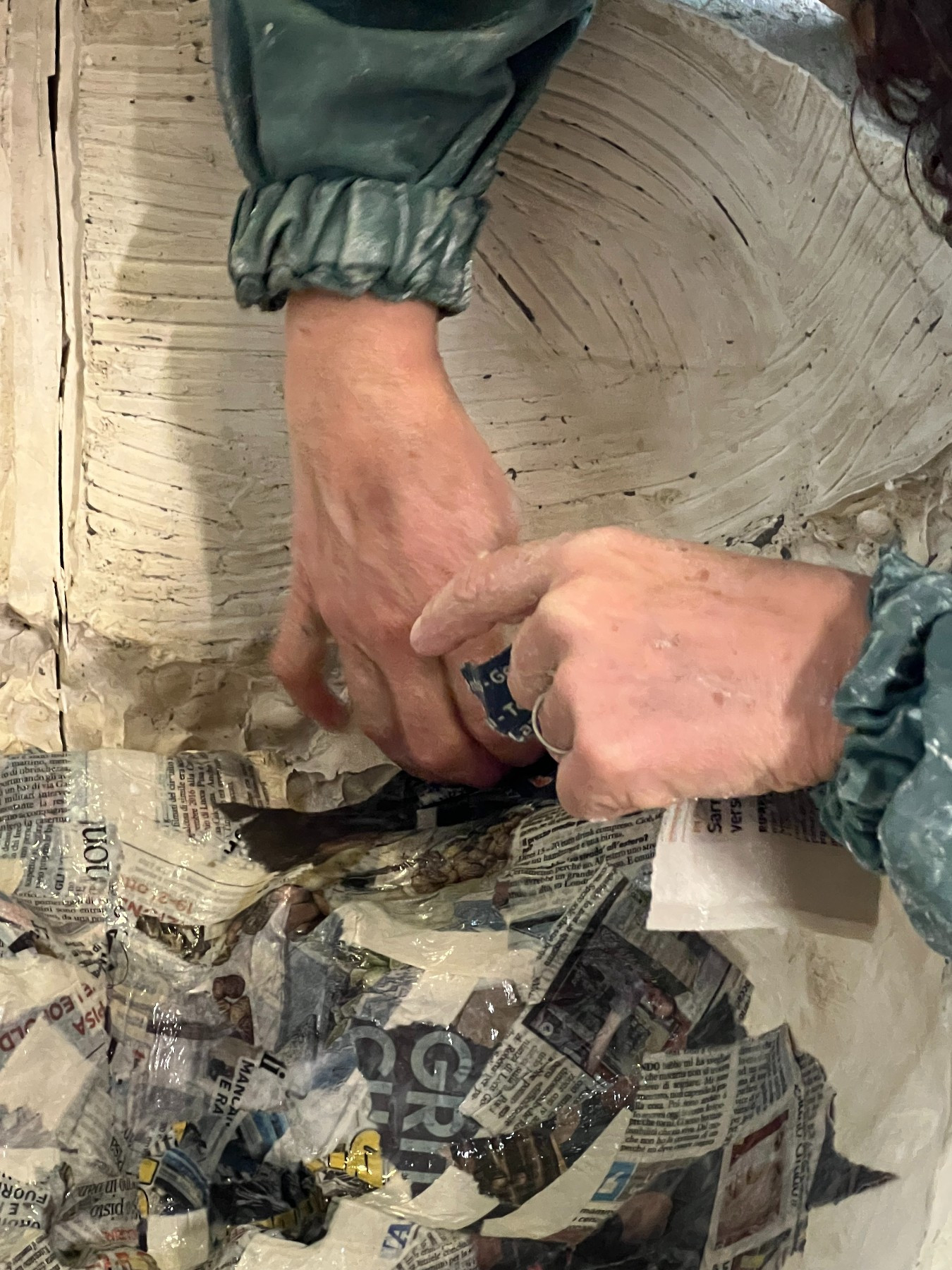
— — —
Matteo Raciti was born in Sicily and grew up in the artistic community of the Carnevale of Acireale studying architecture before coming to Pietrasanta to train as a sculptor with a special interest in puppetry. This year he called his masquerade Humanity has lost the thread, a modern retelling of the Ariadne and the minotaur myth. His minotaurs can't get out of the labyrinths that our society has created. Will they be able to follow the red thread invented by a young Ariadne and find their way to a new humanity?
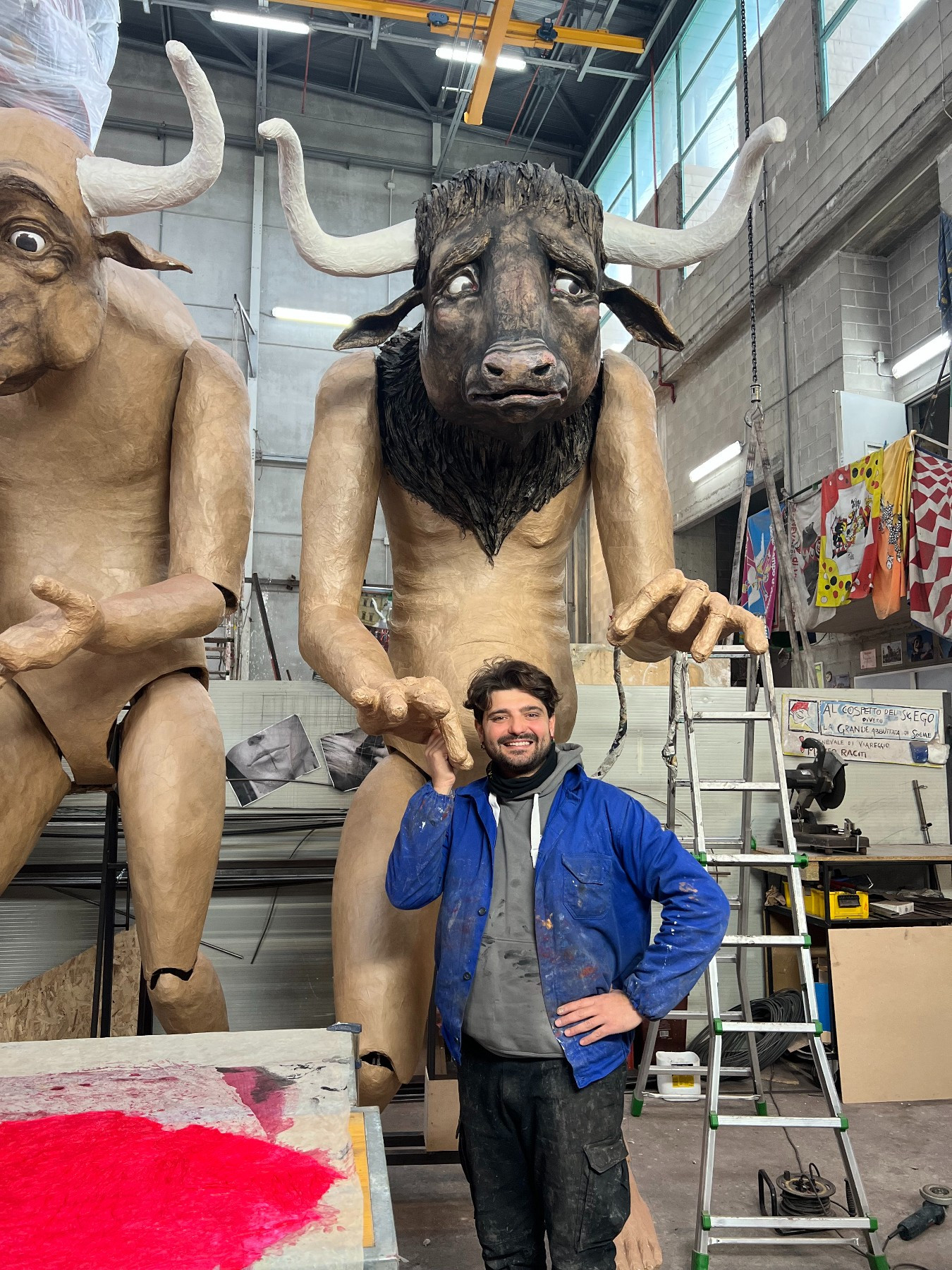
Matteo Raciti with his minotaurs
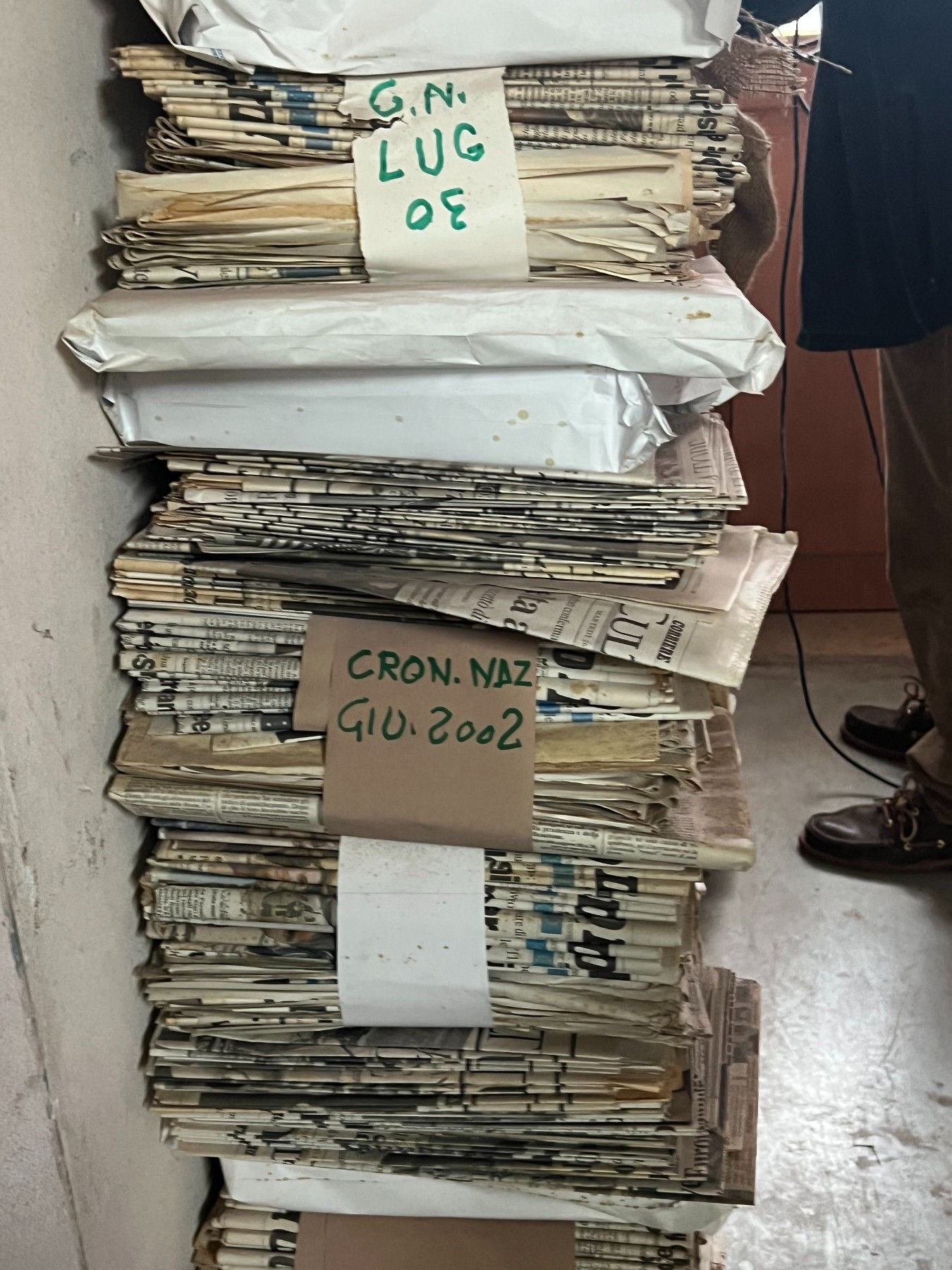
Matteo's dated newspapers
Credits
Producer: Sarah Monk
Sound recording, edit/design: Mike Axinn
Music: courtesy of Audio Network
Balkan House 2527/10, Peter Mayne
Francesco (00:18):
They’re a very old newspaper. You see news from the past and you connect them to nowadays so you can have a connection to the world story, political, economics and so on. We have newspaper from 2014 when there was the war in Crimea. Now we have got war in Crimea, so it is a critical point for the Carnevale. Yeah. We cannot use tablet.
Sarah (00:59):
Hi, this is Sarah with another episode of Materially Speaking where artists and artisans tell their stories through the materials they choose. Today, Mike Axinn and I meet some of the artisans behind the Carnevale of Viareggio. Carnivals originated in pagan rituals celebrating the rebirth of nature as winter turns to spring. In Western Christianity, they also offered a brief hiatus before the rigors of Lent, some say, hence the name ‘carnem levare’, which means to take away meat. Either way, they’re time to create chaos, question and poke fun at authority, and generally have a party. The festival in Viareggio, a Tuscan seaside resort a hundred kilometers to the west of Florence, was first celebrated in 1873, and has now grown to be the very symbol of the town.
(01:50):
The allegorical floats and masks parade exuberantly down the seaside promenade annually each February, attracting about 500,000 spectators. At the Cittadella del Carnevale, a circular complex with a museum and cafe on the edge of Viareggio, we meet with seven artisans in four different hangars. Many of them work in summer as artists in nearby Pietrasanta or have jobs in the seaside life of Viareggio. But from September through March, their focus is on letting their imaginations soar and their hands create in a light and cheap material, paper mache.
(02:29):
It’s January. It’s cold, but there’s energy and excitement in the air as we enter the Cittadella. Music blasts loudly to motivate the workers. A giant outstretched arm claws its way around a hangar door. A model of a monster towers above us, a cherry picker hovering next to it as someone leans over to apply some paint. In the distance, we can hear the feet shuffling, hand clapping sound of dancers rehearsing in a hall.
Benjamin (02:59):
My name is Benjamin Baltazar Lebigre, and I am one of the members of the Lebigre family who’s making floats here in Viareggio. The beautiful thing about Carnival is that it’s really open to everyone. It’s really cool, this melting pot of ages, of colors and…
Elodie (03:20):
I’m Elodie Lebigre and I’m a part of this artistical family. The thing is that we try to make a very professional show with very non-professional people. And it’s very nice because we don’t search for particular skills, but we search for a kind of empathy and energy that develops during these months of rehearsals, and that is a little bit of the magic of the Carnival that comes out.
Benjamin (03:53):
At the beginning, the company was really little and they are still with us since 20 years, and they say that it’s one of the part of the year that they prefer because they learn.
Elodie (04:11):
In 2004, we decided to start a new way of involving people and telling the story together with this big structure, which was then took by also the other builders, and that became now something which is a part of the parade to create a show with the people. All the figurants, 200 figurants, will be clowns and will be acting in the parade. They had meetings with the dancer, professional dancers. Next year it’ll be 20 years of this way of doing the carnival.
Libero (04:51):
My name is Libero, Libero Maggini. I’m from Viareggio. I start to work when I was a boy, as I was a kid, because my father teach me how to do this. He was working in the Carnival, so was naturally. He teach me also do the ceramics and it’s not a job for me. It’s life. It’s normal life.
Edoardo (05:15):
[Foreign language 00:05:16]
Narrator (05:21):
My name is Edoardo Ceragioli and I have been part of a group making masks in the Viareggio Carnival for quite a few years now. I was born in Viareggio and I live in Camaiore, a town near Viareggio. "The Carnival," in quotation marks, is in our blood because I was born on the street right next to the old booths of the Viareggio Carnival that were in Via Marco Polo.
(05:42):
I rightly found myself doing Carnival work, because I realized it was just a stone’s throw away. I went to see if they needed help, and they gave me a job making wagons. They took me under their wing, the same colleagues I have today. After working with them for many years, I developed a passion for papier mache, and thus began the process that brought me to where I am today.
Francesco (06:06):
My name is Francesco. I used to work as a lifeguard during the season, and during winter I work with the Edoardo since 2013. Previously, I had another job. I was unemployed. The company closed and so I was without work. He called me and he asked me to join him in the Carnival. Then I found a job as a lifeguard. And so this is my life since then.
Elodie (06:43):
I started working with my parents, like my brothers also. We all made our experience in working with them and learning the art by them like in the old age.
Libero (06:59):
When I was growing up with the time I start work in Pietrasanta, so I mix everything. In 15 kilometers, you can work in Viareggio, down in the Carnival, or in Pietrasanta where you can do bronze or marble.
Elodie (07:14):
With my family, there’s my mother which came here with my father 40 years ago and started this adventure in carnival. My father passed away, but they were both sculptors and set designers, but they fell in love with this artistical expression.
Corinne (07:33):
My name is Corinne Roger-Lebigre and I came in Italy 40 years ago. [Foreign language 00:07:45]
Narrator (07:46):
What fascinated us, since my husband came from painting and myself from sculpture, was the material. To work in the Carnival is to find a language in the material. It’s a challenge to produce the greatest effect given the budget. It’s kind of a circus trick.
Matteo (08:01):
[Foreign language 00:08:03].
Narrator (08:08):
My name is Matteo Raciti. I’m an artist and an architect. Being Sicilian, I’ve always been fascinated by Sicilian puppets, which have a very long history and deep roots. Already, as a child, my mother brought me to theaters with Sicilian puppets, these marionettes, these puppets, one meter high. What always fascinated me was that although they were clearly not human beings in reality, they transmitted emotions and particular sensations above all to children.
Elodie (08:51):
We are about eight people, let’s say, with different skills. We have a lot of people on the structural part because it’s the biggest part that we have to work on, but everyone knows how to work with papier mache, with the wood, with iron, with other materials that can be used at that moment.
Francesco (09:19):
The figures on the floats moves and so there is the carpenter, I mean the one that works with the iron that have to think about how to move an arm, the head, the eyes and so on in order to satisfy the original idea. It is a [foreign language 00:09:40] stimulating job.
Elodie (09:41):
We are inventors, let’s say. We try to find a lot of solutions in the process. My father used to say we are ninja.
Libero (09:54):
There is no border to the craft one or to the art, something mixed. The only thing that matters is if you can put yourself inside what are you doing. That’s art.
Matteo (10:07):
[Foreign language 00:10:08]
Narrator (10:11):
I love it for many, many reasons. In the meantime, I like the possibility of being able to say something of my own to many people. It’s possible to speak to others and to express myself. I also like it because in it there’s the artistic aspect, but also the artisan aspect. So I work a lot with my hands, but I also work a lot with my head.
Elodie (10:32):
We tell a story like if we were arriving with our world made of papier mache, made of costumes and telling a whole story.
Corinne (10:42):
[Foreign language 00:10:46]
Narrator (10:48):
We always have great discussions. It’s like, what are we going to eat tonight? Where do we do this? How do we do that? My children grew up with this. Generally, we find ourselves in agreement on the subject we want to deal with. It’s always related to the current mood, the environment, problems, life and how do you approach them? The Carnival is a way of desanctifying everything and making fun of ourselves in the face of problems.
Francesco (11:12):
We are a very close team. We are friends for years. So we used to get a pizza or meet together. Okay, I was thinking to do this, this, this. What do you think about it? And so on. We discuss it. It gets input. It is a discussion. And then once it is all fixed, we can start the real job.
Elodie (11:36):
This is a very special place. I don’t know if there are other places like this in the world, made and built just for the construction of floats for Carnival. This was made in the early 2000 and in every angle there’s a artist that work on their own float, so this magic is multiplied by 16.
(12:05):
When you work in an artistic building like this, which is four floor high, it’s huge, but sometimes the unexpected can give you some inspiration to do better or to do something which is more interesting.
Libero (12:22):
People who makes this job are specialized in nothing, but they can do everything. It’s starting in September where you make all the sketches. And after you go to the foundation Carnival, where you present all your job and they give you… It’s like a commission. And then they tell you if your work is able to go during the parade in the winter, and then after if they say yes, you start to work and then…
Francesco (12:57):
The very first passage is the clay. This is technically a positive shape. I mean the real thing. Then you put on it the [foreign language 00:13:08]. I don’t know in English how-
Narrator (13:11):
Gesso alabaster.
Francesco (13:13):
We put it on the clay. It starts as a cream and, like concrete, it gets dry and gets the shape of the previous modeled figure. Then it is the form, we call it the form, is opened. You get the negative of the original.
(13:34):
Then with the paper, we go inside of the form of gesso alabaster and we replicate. We duplicate the positive, but the result is in paper. Then when everything is ready, dried enough and so on, you will get the pieces. We join them together and you will get the original model. Then you painted it. You… He paints it, because it is the artistic part of the job.
Edoardo (14:12):
[Foreign language 00:14:12]
Narrator (14:15):
Every year you have to figure out what you feel, what’s happening around you in the world. So you have to be a little receptive to all the things that can happen to you in that moment. Every year is different. The beauty of this work is that it’s never the same.
Elodie (14:29):
This year is a very special year because it’s 150 years of Carnival here in Viareggio. Our idea is to make an homage to the carnival and to the culture of Italy also, but in the same time to the way in which we see the Carnival as an expression and a vision of the reality. So we make a float that is entitled Ridi Pagliaccio, or the art of being seriously serious.
Matteo (15:01):
[Foreign language 00:15:03]
Narrator (15:05):
This year’s work is titled Humanity Has Lost Its Way, with respect to climate change, with respect to war, with respect to so many things that lead us to act in ways that I don’t actually love. And therefore, the idea is about the possibility of finding a new humanity. It’s a reinterpretation of the myth of the Minotaur, but given a slightly more contemporary angle. The ideas that we’re all Minotaurs. Society, I would say, has created Labyrinths.
(15:31):
It was an idea that came to me during lockdown, that each of us is lost in our own Labyrinth, and this thing is giving birth to strange things inside.
Benjamin (15:40):
Our float wants to be a meme of the emotion that we have through this tragicomical world where we live. So we are making a show with clowns. And clown has the power to say whatever he wants in a poetical, satirical, ironical way.
Elodie (16:02):
We make this big puppet 13 meters high. It will be a clown that makes his makeup in front of a mirror. So you will see the face in the mirror at first, because it’s turned his back to the crowd. And then it will turn and it will look at the world as it was a show itself, and the world show in this moment makes us laugh and makes us cry.
Libero (16:29):
I’m playing with the word. It’s just called Anglicani, and it talks about the queen and dogs. I don’t know why. It’s something very, very stupid or out of the mind. Let’s say that.
Elodie (16:48):
All the elements together make this magic. It’s something which is related to a very ancient and popular need to be together, to express something, to feel this energy, maybe to transform yourself. And this is particular magic. Yes.
Edoardo (17:11):
[Foreign language 00:17:13]
Narrator (17:15):
With the Carnival, reality and fiction come together and we create a theater in the street, with this great interaction among people. And in the Carnival, there is a lot of theater, if you think of commedia dell’arte that is at the root of all theater, but also the Carnival in Italy with all the masks and so on.
Corinne (17:31):
[Foreign language 00:17:41]
Narrator (17:43):
What’s interesting for us is to create these machines for the festival. And when they emerge, it’s a gift, an offering to the public. It’s magic to see people marveling. We all become like children again.
Elodie (17:55):
When you start the engine to make everything work, at that time something happens inside you which is very emotional, very big. And this is probably the thing that makes us do this work.
Francesco (18:09):
It is an occasion to go out. The spring starts. You feel the weather, the warm temperature. You see people that you know. You say hello. You embrace. It is an occasion to meet the people that you don’t see during the year. You have the occasion to stay on the Passeggiata freely. You feel very free during the Carnival.
Libero (18:31):
I have six very tough and big guys who help me, because to be in the parade with this one on the top is not a joke. You know? Have to be very powerful guys. For two, three hours on your back they are 25 kilos. In the middle of the people, in the middle of confusion. So I’m out to check everything is okay. And so in that day I’m very nervous because everybody are playing, but I always scared that something can go wrong.
Elodie (19:14):
The parade is a competition, so there’s people that stands for us, people that stands for another builder. It’s also a part of something that the city possess. It’s theirs also, and you can see it also in the rhythm of the city.
Francesco (19:30):
Because people used to cross the street when the floats are passing and so on. It is quite messy because okay, there is the parade, but there are also the Rione I mean, each week there is a party on the Rioni, and it is the very messy one party during the Carnival. Carnival, you are quite polite. During the Rioni-
Sarah (19:58):
Really? So it’s like the after-parties at the Oscars?
Francesco (20:01):
Yeah, yeah.
Sarah (20:02):
That’s where the real news happens.
Francesco (20:03):
Yeah.
Sarah (20:04):
Okay.
Francesco (20:04):
And the secret news. You feel very free during the Carnival.
Mike Axinn (20:10):
And what’s the craziest thing that, in a good way, your experience was from the Carnival?
Francesco (20:16):
I cannot say. I cannot say.
Matteo (20:20):
[Foreign language 00:20:23]
Narrator (20:27):
The magic of this work, in my opinion is determined by the ephemeral. The fact that these things will be destroyed in a few months. And this is the beautiful thing, because these constructions last for just a short period and then we start again, and therefore the thing every year is like a drug. Every time, every year, it regenerates this desire to start again.
Edoardo (20:47):
[Foreign language 00:20:49].
Narrator (20:51):
Because we are conveying a message to so many people, anyway, at Carnival. For us, it’s a great opportunity that I want to make the most of and not waste every year.
Benjamin (21:01):
It’s a kind of art that I can see. It’s uniting everyone.
Sarah (21:10):
So thanks to Corinne, Elodie, and Benjamin Lebigre, to Edoardo Ceragioli and Francesco Manfre. Also to Libero Maggini and to Matteo Raciti.
(21:21):
You can find links to all of them on our website materiallyspeaking.com and find photos on Instagram at Materially Speaking podcast.
(21:25):
And thanks to you for listening. We hope you enjoy Carnival season wherever you are, and relish the fact that spring is nearly here. If you’re enjoying Materially Speaking, please subscribe to our newsletter on our website, so we can let you know when the next episode goes live.
